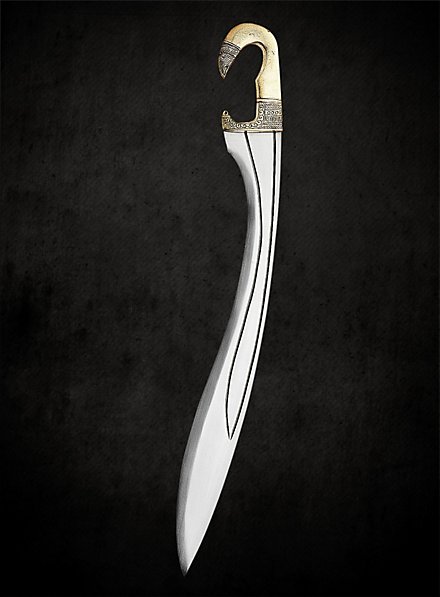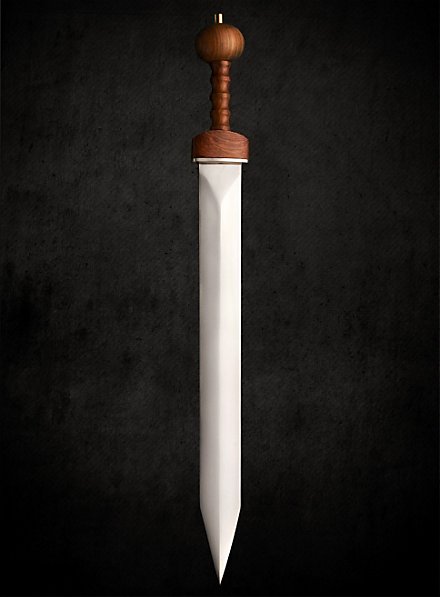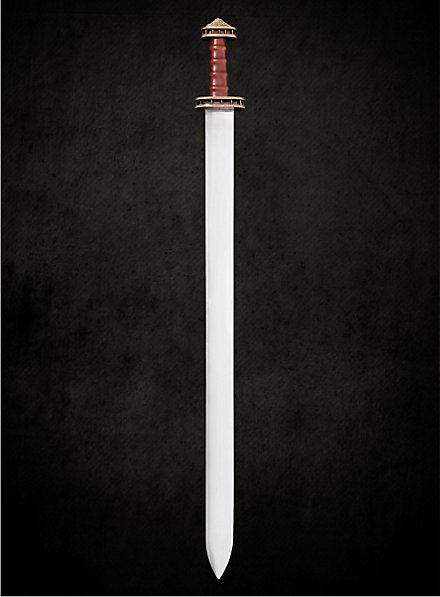In this Article we are dedicating some time to the swords of classical antiquity in Europe, for as we can see from the examples of the kopis, gladius, seax and spatha, it was this time period that most strongly influenced the development of the sword up through the Viking and medieval periods.
The history of swords, however, goes even further back. The oldest sword-like finds in Turkey have been dated back to 3,300 BC. According to prevailing expert opinion, these are not yet the swords as we know them from the Bronze Age. At this stage they are, technically speaking, still long daggers. Discovered and excavated in 1999 with the famous Nebra sky disk, the swords of Nebra, from ca. 1600 BC, are good examples of models from the early Bronze Age.
Owing to the increasing expansion of ever-advancing ironworking technologies (the Hittites were the first to produce steel around 1400 BC), Iron Age swords gradually surpassed those of the Bronze Age starting in the 12th century BC. In particular the realization that an iron and carbon alloy, namely, steel, brought with it the best features for a sword blade was groundbreaking: it could now be produced to be hard and flexible at once while drastically reducing the risk of bent or broken blades.
Because carbon steel (also known as spring steel due to its flexibility) continues to be the end-all be-all of materials for the production of real swords, not much has changed in swords of European antiquity since this break-through aside from shape and size, as you can see from the following examples.
 Greek Short Swords
Greek Short Swords
In ancient Greece, short swords served lance-carrying hoplites as side weapons for close combat. A good example of such a weapon is our Spartan short sword. Its blade is leaf-shaped, a popular shape at the time, indeed the preferred shape among German and Celtic tribes.
Starting in the 4th century BC, the kopis (cf. falcata) with its inward-bending, single-edged blade, joined the hoplites’ weaponry as a cutting sword much feared by their enemies. The kopis, or Hispanic falcata, was used by the Greeks on the Iberian peninsula until ca. 100 AD.
Falcata Basic Info
Period of use: 5th cent. BC – 1st cent. BC
Total length: approx. 65 – 70 cm
Blade length: approx. 50 cm
 Roman Gladius
Roman Gladius
For a long time the gladius (lat.: sword) was the preferred one-handed edged weapon of the ancient Roman Empire. From around 300 BC to 300 AD, the infantry of the Roman legions wielded such short swords and are still referred to as gladii nowadays. In the common parlance of the time any sword was a gladius. The most well-known types of gladii were the Mainz and Pompeii, which differ from one another with respect to their blade shape – the Pompeii blade is straight, while the Mainz blade is leaf-shaped and tapered. Both share a largely identical grip with a sphere-shaped pommel and are particularly suited for thrusting out of narrow battle formations, while its double-edged blade is also capable of cutting.
Gladius Basic Info
Period of use: 3rd cent. BC – 3rd cent. AD
Total length: 70 – 75 cm
Blade length: 50 – 55cm
 Merovingian Seax
Merovingian Seax
What the gladius was for the Romans during the turn of the eras the seax was for German tribes. Starting around 300 BC, seaxes were used as hunting and military weapons. In fact, the name of the Saxon tribe derives from the seax. It has a distinctive blade form in that its cutting edge is on the long side of the single-edged blade, and it transitions into the hilt without recess. The seax’s simple construction hardly changed throughout the 5th century AD, which qualifies this model as pre-Merovingian. Starting in 400 AD, various types of seax can be differentiated based on the requirements they fulfilled—the short seax was used as a dagger-like cutter, narrow and broad saxes were used as machetes, and the long seax was wielded in a similar fashion as the sword.
Seax Basic Info
Period of use: 4th cent. BC – 5th cent. AD
Total length: 50 – 100 cm
Blade length: 40 – 80 cm
 The Spatha as a Precursor of “Modern” Swords
The Spatha as a Precursor of “Modern” Swords
Used by the Celts as a riding sword, the spatha is the long runner of European antiquity. Celtic cavalry units brought it to Rome where it found its way into the Roman arsenal. Primarily conceived as a cutting sword, it was double-edged and was used under Emperor Adrian in the regular Roman cavalry, ultimately replacing the gladius that the infantry used. Around the turn of the millennium, German tribes had also adopted the spatha from the Celts, elaborating upon its design. It then spread throughout all of Europe during the Migration Period.
As the predecessor of the Viking sword and consequently, the medieval riding sword, the spatha was on the scene well into the 11th century. Even though it had already peaked with the emergence of the Viking sword in the 7th and 8th centuries.
Spatha Basic Info
Period of use: 3rd cent. BC – 11th cent. AD
Total length: 75 – 110 cm
Blade length: 55 – 100 cm



